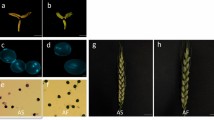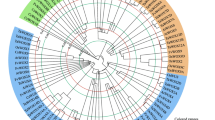Abstract
RING finger proteins are the most abundant proteins in plants and may be essential for diverse aspects of cellular regulation in plant growth and development. Many RING finger proteins are E3 ubiquitin ligases, which play important roles in protein-protein interactions and ubiquitin-dependent protein degradation. The TaRF1 gene encodes a novel RING finger protein. In this study, we characterized the wheat (Triticum aestivum) RING finger domain as a hexapoid wheat ubiquitin ligase. To study the role of TaRF1 in wheat, we isolated TaRF1 from wheat spike cDNA. TaRF1 was 756 bp and encoded a putative 251-amino-acid with a predicted molecular mass of 28.57 kDa and isoelectric point of 5.75. A typical C3HC4-type RING finger domain was found at the C-terminal region of the TaRF1 protein. TaRF1 expression was investigated in the developmental stages and under various stresses by using reverse transcription polymerase chain reaction and was confirmed by subcellular localization of TaRF1 labeled with green fluorescent protein. Using the yeast 2-hybrid screen, we identified potential TaRF1-interacting proteins in a wheat spike library. Among the 8 clones that were identified as potential interacting partners of TaRF1 using yeast 2-hybrid screening, we found the strongest interaction between TaRF1 and the ubiquitin E2 enzyme TaUBC28 in tobacco leaves through biomolecular fluorescence complementation. The selectivity of interactions between E2 enzymes and RING E3 ligases represents a central and crucial part of the ubiquitin-conjugation pathways in organisms. These results indicate that the TaRF1 protein can interact with TaUBC28 in vitro and in vivo.




Similar content being viewed by others
Abbreviations
- BiFC:
-
Biomolecular fluorescence complementation
- GFP:
-
Green fluorescent protein
- HECT:
-
Homologous to the E6-AP carboxyl terminus
- RING:
-
Really interesting new gene
- Y2H:
-
Yeast 2-hybrid
References
Abramoff MD, Magelhaes PJ, Ram SJ (2004) Image processing with ImageJ. Biophoton Int 11:36–42
Barlow P, Luisi B, Milner A, Elliott M, Everett R (1994) Structure of the C3HC4 domain by 1H-nuclear magnetic resonance spectroscopy. A new structural class of zinc-finger. J Mol Biol 237:201–211
Borden KLB, Freemont PS (1996) The RING finger domain: a recent example of a sequence—structure family. Curr Opin Struct Biol 6:395–401
Chen H, Nelson R, Sherwood J (1994) Enhanced recovery of transformants of Agrobacterium tumefaciens after freeze-thaw transformation and drug selection. Biotechniques 16:664–668
Chen D, Molitor A, Liu C, Shen WH (2010) The Arabidopsis PRC1-like ring-finger proteins are necessary for repression of embryonic traits during vegetative growth. Cell Res 20:1332–1344
Dasgupta A, Ramsey KL, Smith JS, Auble DT (2004) Sir Antagonist 1 (San1) is a ubiquitin ligase. J Biol Chem 279:26830–26838
Deshaies RJ, Joazeiro CAP (2009) RING domain E3 ubiquitin ligases. Annu Rev Biochem 78:399–434
Dong CH, Agarwal M, Zhang Y, Xie Q, Zhu JK (2006) The negative regulator of plant cold responses, HOS1, is a RING E3 ligase that mediates the ubiquitination and degradation of ICE1. Proc Natl Acad Sci USA 103:8281–8286
Glickman MH, Ciechanover A (2002) The ubiquitin-proteasome proteolytic pathway: destruction for the sake of construction. Physiol Rev 82:373–428
Guerra DD, Callis J (2012) Ubiquitin on the move: the ubiquitin modification system plays diverse roles in the regulation of endoplasmic reticulum-and plasma membrane-localized proteins. Plant Physiol 160:56–64
Hardtke CS, Okamoto H, Stoop–Myer C, Deng XW (2002) Biochemical evidence for ubiquitin ligase activity of the Arabidopsis COP1 interacting protein 8 (CIP8). Plant J 30:385–394
Hellmann H, Estelle M (2002) Plant development: regulation by protein degradation. Science 297:793–797
Hong MJ, Kim DY, Kang SY, Kim DS, Kim JB, Seo YW (2012) Wheat F-box protein recruits proteins and regulates their abundance during wheat spike development. Mol Biol Rep 39:9681–9696
Hua Z, Vierstra RD (2011) The cullin-RING ubiquitin-protein ligases. Annu Rev Plant Biol 62:299–334
Imai J, Maruya M, Yashiroda H, Yahara I, Tanaka K (2003) The molecular chaperone Hsp90 plays a role in the assembly and maintenance of the 26S proteasome. EMBO J 22:3557–3567
Kraft E, Stone SL, Ma L, Su N, Gao Y, Lau OS, Deng XW, Callis J (2005) Genome analysis and functional characterization of the E2 and RING-type E3 ligase ubiquitination enzymes of Arabidopsis. Plant Physiol 139:1597–1611
Lee HK, Cho SK, Son O, Xu Z, Hwang I, Kim WT (2009) Drought stress-induced Rma1H1, a RING membrane-anchor E3 ubiquitin ligase homolog, regulates aquaporin levels via ubiquitination in transgenic Arabidopsis plants. Plant Cell 21:622–641
Lorick KL, Jensen JP, Fang S, Ong AM, Hatakeyama S, Weissman AM (1999) RING fingers mediate ubiquitin-conjugating enzyme (E2)-dependent ubiquitination. Proc Natl Acad Sci USA 96:11364–11369
Mabb AM, Ehlers MD (2010) Ubiquitination in postsynaptic function and plasticity. Annu Rev Cell Dev Biol 26:179–210
Nakamura N (2011) The role of the transmembrane RING finger proteins in cellular and organelle function. Membranes 1:354–393
Pratt WB, Krishna P, Olsen LJ (2001) Hsp90-binding immunophilins in plants: the protein movers. Trends Plant Sci 6:54–58
Qin R, Gao S, McDonald JA, Ajwa H, Shem-Tov S, Sullivan DA (2008) Effect of plastic tarps over raised-beds and potassium thiosulfate in furrows on chloropicrin emissions from drip fumigated fields. Chemosphere 72:558–563
Richter K, Buchner J (2001) Hsp90: chaperoning signal transduction. J Cell Physiol 188:281–290
Song XJ, Huang W, Shi M, Zhu MZ, Lin HX (2007) A QTL for rice grain width and weight encodes a previously unknown RING-type E3 ubiquitin ligase. Nat Genet 39:623–630
Sonoda Y, Yao SG, Sako K, Sato T, Kato W, Ohto M, Ichikawa T, Matsui M, Yamaguchi J, Ikeda A (2007) SHA1, a novel RING finger protein, functions in shoot apical meristem maintenance in Arabidopsis. Plant J 50:586–596
Stone SL, Hauksdóttir H, Troy A, Herschleb J, Kraft E, Callis J (2005) Functional analysis of the RING-type ubiquitin ligase family of Arabidopsis. Plant Physiol 137:13–30
VanDemark AP, Hill CP (2002) Structural basis of ubiquitylation. Curr Opin Struct Biol 12:822–830
Walter M, Chaban C, Schütze K, Batistic O, Weckermann K, Näke C, Blazevic D, Grefen C, Schumacher K, Oecking C (2004) Visualization of protein interactions in living plant cells using bimolecular fluorescence complementation. Plant J 40:428–438
Wang F, Deng XW (2011) Plant ubiquitin-proteasome pathway and its role in gibberellin signaling. Cell Res 21:1286–1294
Wang W, Vinocur B, Shoseyov O, Altman A (2004) Role of plant heat-shock proteins and molecular chaperones in the abiotic stress response. Trends Plant Sci 9:244–252
Wen R, Newton L, Li G, Wang H, Xiao W (2006) Arabidopsis thaliana UBC13: implication of error-free DNA damage tolerance and Lys63-linked polyubiquitylation in plants. Plant Mol Biol 61:241–253
Wydro M, Kozubek E, Lehmann P (2006) Optimization of transient Agrobacterium-mediated gene expression system in leaves of Nicotiana benthamiana. Acta Biochim Pol 53:289–298
Xie Q, Guo HS, Dallman G, Fang S, Weissman AM, Chua NH (2002) SINAT5 promotes ubiquitin-related degradation of NAC1 to attenuate auxin signals. Nature 419:167–170
Xu R, Quinn Li Q (2003) A RING-H2 zinc-finger protein gene RIE1 is essential for seed development in Arabidopsis. Plant Mol Biol 53:37–50
Young JC, Moarefi I, Hartl FU (2001) Hsp90: a specialized but essential protein-folding tool. J Cell Biol 154:267–273
Yu Y, Xu W, Wang S, Xu Y, Li H, Wang Y, Li S (2011) VpRFP1, a novel C4C4-type RING finger protein gene from Chinese wild Vitispseudoreticulata, functions as a transcriptional activator in defence response of grapevine. J Exp Bot 62:5671–5682
Zhang Y (2003) Transcriptional regulation by histone ubiquitination and deubiquitination. Genes Dev 17:2733–2740
Zhang X, Garreton V, Chua NH (2005) The AIP2 E3 ligase acts as a novel negative regulator of ABA signaling by promoting ABI3 degradation. Genes Dev 19:1532–1543
Acknowledgments
This research was supported by the Technology Development Program for Agriculture and Forestry, Ministry for Food, Agriculture, Forestry and Fisheries, Republic of Korea. This work was also supported by a grant from the Next-Generation Bio-Green 21 Program (Plant Molecular Breeding Center No. PJ0080312012), Rural Development Administration, Republic of Korea. This research was also supported by National Nuclear R&D Program through the National Research Foundation of Korea (NRF), funded by the Ministry of Education, Science, and Technology (No. 2012M2A2A6035566).
Author information
Authors and Affiliations
Corresponding author
Electronic supplementary material
Below is the link to the electronic supplementary material.
ESM 1
(DOCX 630 kb)
Rights and permissions
About this article
Cite this article
Hong, M.J., Seo, Y.W. A potential role of UBC28 interacting RING finger protein TaRF1 in spike development of wheat. J. Plant Biochem. Biotechnol. 23, 421–429 (2014). https://doi.org/10.1007/s13562-013-0227-5
Received:
Accepted:
Published:
Issue Date:
DOI: https://doi.org/10.1007/s13562-013-0227-5




